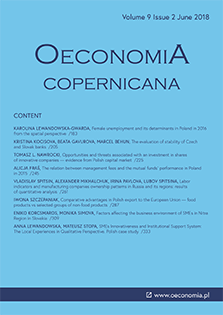Opportunities and threats associated with an investment in shares of innovative companies — evidence from Polish capital market
Opportunities and threats associated with an investment in shares of innovative companies — evidence from Polish capital market
Author(s): Tomasz L. NawrockiSubject(s): Business Economy / Management, Financial Markets, Accounting - Business Administration
Published by: Instytut Badań Gospodarczych
Keywords: corporate innovativeness; innovative company; investment strategies; risk-return analysis;
Summary/Abstract: Research background: Since the Internet bubble, which took place at the turn of XX and XXI century, on the global capital markets, including Poland, one may note a growing interest in companies focusing on innovations and innovativeness. The main driver of this interest is the belief that in a longer term innovations and expenditures on research and development will translate into an increase in competitive advantage, financial results, and subsequently also the market value of companies. On the other hand, the attention should also be paid to the fact that innovative activity has also another, darker, side, which is identified with the far-reaching uncertainty about its final effects and the possibility of incurring losses, especially in financial dimension. At the same time, it should be noted that implementation of investment strategy regarding the shares of innovative companies is quite troublesome because of the lack of unified methodology for assessing corporate innovativeness and large information diversity in this area. Purpose of the article: The investment efficiency analysis of investment strategy regarding shares of companies perceived to be innovative with simultaneous focusing on the different cases of situation development in time. Methods: The research was carried out for companies listed on the main market of the Warsaw Stock Exchange, taking into consideration various time ranges of investment. The efficiency analysis of this investment strategy was conducted in the risk-return outlay with the use of such measures as: accumulated rate of return, arithmetic average rate of return, standard and semi-standard deviation, as well as coefficients of variation and semi-variation of rate of return and their inverses. Findings & Value added: The obtained results show that in shorter periods of time, investors buy expectations connected with innovative companies and therefore, the efficiency of investment in their shares is relatively high, but in the longer term expectations are revised by companies’ financial results, which in turn often negatively affects the investment efficiency.
Journal: Oeconomia Copernicana
- Issue Year: 9/2018
- Issue No: 2
- Page Range: 225-244
- Page Count: 20
- Language: English

